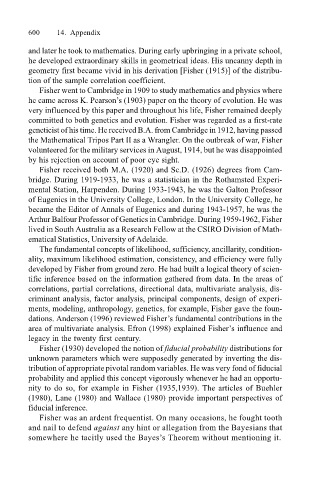Page 623 - Probability and Statistical Inference
P. 623
600 14. Appendix
and later he took to mathematics. During early upbringing in a private school,
he developed extraordinary skills in geometrical ideas. His uncanny depth in
geometry first became vivid in his derivation [Fisher (1915)] of the distribu-
tion of the sample correlation coefficient.
Fisher went to Cambridge in 1909 to study mathematics and physics where
he came across K. Pearsons (1903) paper on the theory of evolution. He was
very influenced by this paper and throughout his life, Fisher remained deeply
committed to both genetics and evolution. Fisher was regarded as a first-rate
geneticist of his time. He received B.A. from Cambridge in 1912, having passed
the Mathematical Tripos Part II as a Wrangler. On the outbreak of war, Fisher
volunteered for the military services in August, 1914, but he was disappointed
by his rejection on account of poor eye sight.
Fisher received both M.A. (1920) and Sc.D. (1926) degrees from Cam-
bridge. During 1919-1933, he was a statistician in the Rothamsted Experi-
mental Station, Harpenden. During 1933-1943, he was the Galton Professor
of Eugenics in the University College, London. In the University College, he
became the Editor of Annals of Eugenics and during 1943-1957, he was the
Arthur Balfour Professor of Genetics in Cambridge. During 1959-1962, Fisher
lived in South Australia as a Research Fellow at the CSIRO Division of Math-
ematical Statistics, University of Adelaide.
The fundamental concepts of likelihood, sufficiency, ancillarity, condition-
ality, maximum likelihood estimation, consistency, and efficiency were fully
developed by Fisher from ground zero. He had built a logical theory of scien-
tific inference based on the information gathered from data. In the areas of
correlations, partial correlations, directional data, multivariate analysis, dis-
criminant analysis, factor analysis, principal components, design of experi-
ments, modeling, anthropology, genetics, for example, Fisher gave the foun-
dations. Anderson (1996) reviewed Fishers fundamental contributions in the
area of multivariate analysis. Efron (1998) explained Fishers influence and
legacy in the twenty first century.
Fisher (1930) developed the notion of fiducial probability distributions for
unknown parameters which were supposedly generated by inverting the dis-
tribution of appropriate pivotal random variables. He was very fond of fiducial
probability and applied this concept vigorously whenever he had an opportu-
nity to do so, for example in Fisher (1935,1939). The articles of Buehler
(1980), Lane (1980) and Wallace (1980) provide important perspectives of
fiducial inference.
Fisher was an ardent frequentist. On many occasions, he fought tooth
and nail to defend against any hint or allegation from the Bayesians that
somewhere he tacitly used the Bayess Theorem without mentioning it.

